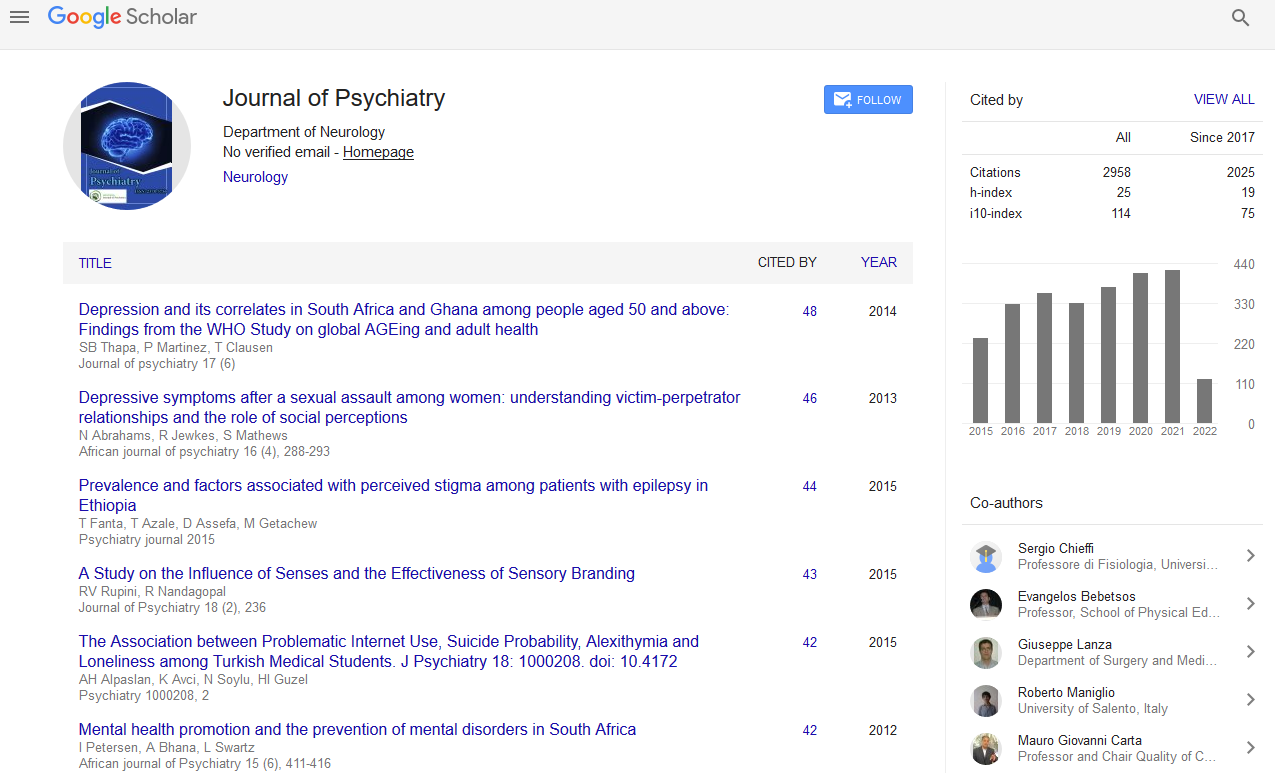PMC/PubMed Indexed Articles
Indexed In
- RefSeek
- Hamdard University
- EBSCO A-Z
- OCLC- WorldCat
- SWB online catalog
- Publons
- International committee of medical journals editors (ICMJE)
- Geneva Foundation for Medical Education and Research
Useful Links
Share This Page
Open Access Journals
- Agri and Aquaculture
- Biochemistry
- Bioinformatics & Systems Biology
- Business & Management
- Chemistry
- Clinical Sciences
- Engineering
- Food & Nutrition
- General Science
- Genetics & Molecular Biology
- Immunology & Microbiology
- Medical Sciences
- Neuroscience & Psychology
- Nursing & Health Care
- Pharmaceutical Sciences
Short Communication - (2020) Volume 23, Issue 4
Psychiatry 2019: Exploring ocular and head kinematics in an immersive virtual environment for post-stroke neurorehabilitation - University of Amsterdam
Caroline Marilou de Booij*, DOI: 10.35248/2378-5756.20.23.472
Abstract
In the Netherlands, about 43,000 people suffer a stroke each year, and more than 320,000 people have to cope with its consequences. Following a stroke, brain cells in the tissue surrounding the injury die, resulting in motor impairment and cognitive disabilities. Since current forms of rehabilitation are very tiring and repetitive for patients, novel effective rehabilitation approaches using serious gaming and virtual reality (VR) are being developed. With serious gaming, it is possible to study how people with cognitive disabilities, sometimes combined with ocular and/or motor deficits, observe their environment and process visual information. For instance, the standard tests for the assessment of post-stroke visual neglect are only useful when identifying peri-personal neglect (near space), and not personal (body) or extra-personal (far space) neglect. The shortcoming of screening for neglect in the extra-personal space can be overcome by using stereoscopic imaging in VR, which enables a three-dimensional environment. Furthermore, the field of view could be adapted during execution of different cognitive tasks to what the individual is able to see following post-stroke neglect or visual field loss. Consequently, assistive eye- and head-tracking technologies should be integrated with a VR environment to observe the gaze patterns and head movements of stroke patients. This assessment would allow more personalized rehabilitation and could possibly detect whether additional visual treatment is necessary. In this way, cognitive recovery will be accelerated by taking into account the possibilities of eye- and head-tracking in virtual environments for optimal cognitive assessment and rehabilitation following different types of stroke.
Keywords
Devices, Neurorehabilitation, Virtual reality
Background
Virtual reality (VR) encounters (through games and virtual conditions) are progressively being utilized in physical, intellectual, and mental intercessions. Be that as it may, the effect of VR as a way to deal with recovery isn't completely comprehended, and its favorable circumstances over customary restoration procedures are yet to be built up.
Virtual reality is basically a route for people to outwardly interface with, control, and connect with PCs. Augmented reality can be viewed as a propelled type of human-PC collaboration that permits clients to become inundated inside engineered PC created virtual situations. The making of a connected with VR client experience can be cultivated utilizing blends of a wide assortment of collaboration gadgets, tangible presentation frameworks, and substance introduced in the virtual condition. Virtual reality can be an absolutely vivid involvement with PC produced situations with 3-dimensional (3D) pictures or articles. In VR standards, members can investigate with a view of the real world. We along these lines note that the interest attributes of such VR settings can encourage the exercises required by recovery programs, however as a major aspect of an additionally captivating encounter. The VR-based exploratory methodologies have been found to offer focal points for people with extreme engine impairment,16 and considers have exhibited improved inspiration.
Method
We present a systematic review which was conducted according to Preferred Reporting Items for Systematic Reviews and Meta-Analyses (PRISMA). During February and March of 2018, we conducted searches on PubMed (Medline), Virtual Health Library Search Portal databases (BVS), Web of Science (WOS), and Embase for all VR-related publications in the past 4 years (2015, 2016, 2017, and 2018). The keywords used in the search were “neurorehabilitation” AND “Virtual Reality” AND “devices.”
Results
We sum up the writing which features that a scope of viable VR approaches are accessible. Studies distinguished were directed with post stroke patients, patients with cerebral paralysis, spinal string wounds, and different pathologies. Sound populaces have been utilized in the turn of events and testing of VR approaches intended to be utilized later on by individuals with neurological issues. A scope of advantages were related with VR mediations, remembering improvement for engine capacities, more prominent network support, and improved mental and intellectual capacity.
Conclusions
The results from this review provide support for the use of VR as part of a neurorehabilitation program in maximizing recovery.
This work is partly presented at 28th International Conference on Psychiatry & Psychology Health, May 06-07, 2019 | Amsterdam, Netherlands


